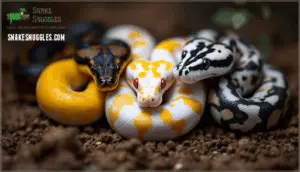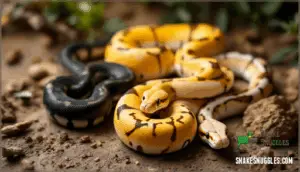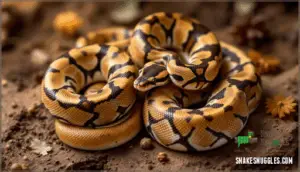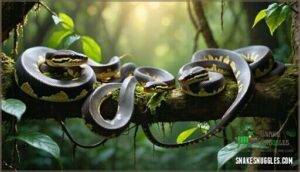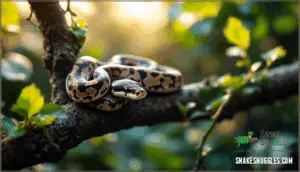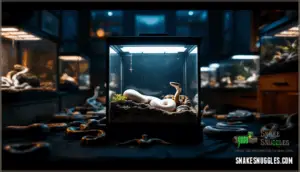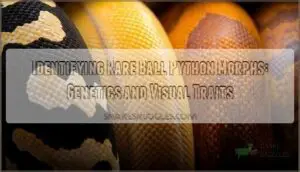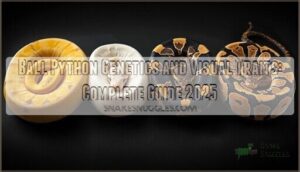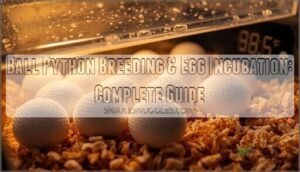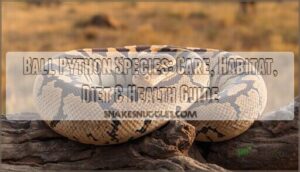This site is supported by our readers. We may earn a commission, at no cost to you, if you purchase through links.
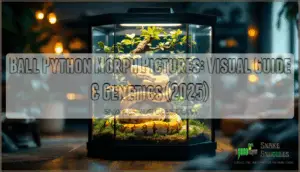
The exotic pet market hit $800 million in 2024, fueled by breeders who treat genetics like an art form and collectors who chase morphs the way others chase rare sneakers. These aren’t just pets anymore—they’re living investments, status symbols, and proof that selective breeding can turn a wild-caught species into thousands of visually distinct designer animals.
Table Of Contents
Key Takeaways
- Ball python morphs range from $40 common varieties to $70,000 rare specimens, with pricing driven by genetic complexity, breeding difficulty, and market saturation that can crash values by 99% in a decade.
- Over 4,000 recognized morphs stem from 18 base genetics (albino, pastel, piebald), but at least 21 morphs carry serious health defects like spider wobble syndrome and duckbill deformities that ethical breeders must actively avoid.
- The exotic pet market hit $800 million in 2024, yet most hobby breeders report zero net income despite moving 20 animals annually as marketplace listings collapsed from 50,000 to 25,000 pythons between 2023–2025.
- Creating rare designer morphs like dreamsicle requires four generations of selective breeding, precise genetic testing, and controlled husbandry with 88–92°F hot spots and 50–60% humidity to ensure viable offspring.
Ball Python Morphs: Visual Gallery and Identification
You’re about to see what separates one ball python morph from another—color, pattern, and genetics all wrapped into distinct visual packages.
This gallery breaks down the morphs you’ll encounter most often, from classic staples to jaw-dropping designer combinations.
Use these images to sharpen your eye and build confidence in identifying what makes each morph unique.
Acid, Albino, and Axanthic Morph Pictures
Three of the most visually striking and beginner-friendly morphs you’ll encounter start with the letter A—and each one brings a completely different palette to the table. When photographing ball python morphs, these three showcase distinct morph color patterns that make them essential for understanding ball python genetics.
- Acid Ball Python: Dark brown or black base layered with golden brown spots—a classic high-contrast pattern
- Albino Ball Python: Yellow and white scales paired with signature pink eyes that define amelanistic genetics
- Axanthic Ball Python: Silver, black, and white markings creating a grayscale aesthetic that defies typical reptile care tips
Banana, Black, and Bongo Pastel Morph Images
Moving past the grayscale and golden tones, you’ll find morphs that bring everything from bright yellows to deep ebony—and even striking combinations that blend multiple genetics into one unforgettable snake.
- Banana Ball Python: Tan base with bold yellow blotches—a co-dominant gene that’s become a staple in ball python morphs breeding
- Black Ball Python: Single black line running parallel to the spine, offering minimalist elegance for reptile habitat design
- Bongo Pastel Ball Python: Combines bongo and pastel morphs into layered morph color patterns that demand attention in snake photography tips
Candy, Champagne, Chocolate, and Cinnamon Morph Photos
These four morphs share names pulled from the dessert menu, but their visual impact comes from rich browns, soft tans, and color-shifting genetics that keep breeders coming back for more.
Chocolate morphs boast caramel keyholes, Cinnamon’s dark coils add drama, while Champagne’s stripped-down pattern and Candy’s evolving hues challenge both snake photography tips and python habitat design for true Ball Python morph color pattern variety.
Rare and Designer Morphs: Dreamsicle, Scaleless, Purple Passion
When the standard palette no longer cuts it, rare and designer morphs like Dreamsicle, Scaleless, and Purple Passion push the boundaries of what’s possible with selective breeding—and they come with price tags and breeding timelines that prove it.
Dreamsicle breeding demands four generations, Scaleless care requires specialized husbandry for animals hitting $2,500, and Purple Passion genetics layer Mojave over Phantom for deep, age-dependent purples.
These designer morph trends showcase genetic mutation at its boldest, redefining Ball Python morphs and reptile genetics while challenging conventional color morphs with every clutch.
Identifying Key Morph Characteristics
You can’t master what you can’t identify—spotting the visual markers that define each morph is where breeding decisions, pricing judgments, and collection goals all begin. Eye coloration separates leucistics from albinos, scale texture distinguishes scaleless lines, and skin markings reveal genetic variation.
Study morph pattern shifts across morph development—color genetics express differently as your snake matures, turning what looks like one animal color morph into another over time.
Ball Python Morph Genetics Explained
Understanding ball python genetics gives you control over your breeding outcomes and unlocks the potential to create stunning morphs.
The genetic foundation of these snakes isn’t as complicated as it looks once you break down the key inheritance patterns.
Here’s what you need to know about how morph genetics actually work.
Base Morphs and Genetic Foundations
At least 18 base morphs form the genetic backbone of the entire ball python breeding industry, serving as the original building blocks that have spawned over 4,000 recognized variations. These foundational genetics emerged from wild populations, where isolated mutations caught the eye of early breeders who recognized their potential for morph development.
Key base morphs driving genetic variation include:
- Albino – eliminates melanin production, establishing base colors of yellow and white
- Pastel – brightens natural pigmentation through co-dominant trait expression
- Piebald – creates unpatterned white patches through recessive morph inheritance
Your understanding of these foundations unlocks the entire world of ball python genetics. Through strategic hybridization and genetic research into animal genetics, breeders manipulate these base traits to engineer designer combinations that push the boundaries of what’s possible in reptile morphs.
Dominant, Co-Dominant, and Recessive Traits
Understanding genetic inheritance transforms how you approach ball python morphs. Dominant traits like Black Pastel express fully with just one copy of the gene, guaranteeing visible trait expression in offspring. Co-dominant genetics, seen in Pastel morphs, produce intermediate heritability patterns—one copy brightens colors, while two copies create "super" forms with intensified visual impact.
Recessive morphs such as Piebald demand two gene copies for expression, requiring strategic gene interaction across multiple generations to achieve morph stability.
Breeding ball pythons requires knowledge of genetic variation principles to predict and produce desired morphs.
How New Morphs Are Developed
New morphs emerge when breeders spot spontaneous mutations in offspring—those unexpected color shifts or pattern breaks that don’t match either parent—and then lock them in through calculated pairings over multiple generations.
Morph creation relies on trait selection through hybridization methods that isolate specific genetic mutations. You’ll test-breed potential carriers, document inheritance patterns, and improve breeding techniques until the new ball python morph breeds true.
This morph development process can span years, demanding patience and precise record-keeping to stabilize genetics.
Genetic Challenges and Breeding Considerations
Breeding ball pythons isn’t just mixing colors—it’s traversing genetic landmines that can compromise animal welfare if you’re not paying attention. Morph inheritance follows predictable patterns, but certain combinations trigger serious defects that ethical breeders actively avoid through genetic testing and outcrossing strategies.
Here are some critical genetic issues to consider:
- Spider Complex morphs consistently show neurological wobble, with severity varying from mild head tremors to life-threatening coordination loss
- Super Cinnamon and Super Black Pastel produce duckbill facial deformities and occasional spinal kinking that affects feeding and movement
- Desert morph females experience significant fertility reduction, often failing to produce viable eggs despite successful breeding attempts
- Caramel Albino lines carry higher rates of spinal kinking and female sub-fertility, reducing productive breeder stock
- Inbreeding risks magnify recessive defects, making outcrossing with wild-type or unrelated stock essential for defect prevention
Modern reptile breeding techniques now include miniPCR genetic testing to identify problematic alleles before pairing, giving breeders control over morph development outcomes. Ball python breeding demands a balance between aesthetic goals and genetic realities—creating stunning animals shouldn’t mean sacrificing their quality of life. By utilizing genetic testing tools, breeders can make informed decisions to improve the health and well-being of their ball pythons.
Morph Pricing, Rarity, and Market Trends
Understanding ball python morph pricing gives you control over your breeding investments and collection goals. The market shifts fast, and knowing what drives value separates savvy breeders from those who overpay.
Here’s what shapes the economics of morphs in 2025.
Common Morph Price Ranges
Most ball python morphs won’t break the bank—common varieties usually cost between and 0, making them accessible entry points for breeders ready to dive into the genetics game without emptying their wallets. Albino, axanthic, and fire morphs sit comfortably in the $200 range, while banana morphs push closer to $300. These pet pricing sweet spots reflect stable supply chains and predictable breeding outcomes—your foothold into understanding how morph rarity and breeder costs shape the reptile morphs market.
| Morph Type | Price Range |
|---|---|
| Basic Morphs | $40 – $100 |
| Standard Designer | $200 – $300 |
| Mid-Tier Varieties | $250 – $800 |
High-End and Rare Morph Market Values
Beyond budget-friendly morphs, the luxury collecting frontier showcases specimens commanding jaw-dropping investments. Sunset ball pythons have sold for $70,000, while paradox and stranger morphs reach $30,000—proof that rare genetics drive serious market volatility in snake morphs circles.
- Blue-eyed leucistic varieties hover around $800, balancing accessibility with designer appeal
- Scaleless morphs push $2,500, reflecting niche demand in reptile morphs development
- Investment breeders target $5,000–$70,000 specimens, banking on limited breeder networks
- Monthly revenue for elite morph development operations hits $5,000–$15,000 during peak seasons
Factors Affecting Morph Rarity
Genetic Variance decides whether your ball python morphs become unicorns or commodity stock. Single-gene mutations like pastel flood markets fast—banana morphs crashed from $30,000 to under $200 in ten years. Multi-gene combos stay scarce longer since breeding practices require generations to lock in traits.
Founder effect matters: morphs from one wild-caught specimen start extremely rare. Regulatory impact restricts defective lines like spider (wobble syndrome), while morph demand shifts as collectors chase novel genetic traits.
Snake genetics complexity and health issues—21 morphs carry deformities—keep some perpetually rare despite market trends.
Market Fluctuations and Breeder Insights
Supply and demand mechanics hit hard—between 2023 and 2025, major marketplace listings collapsed from 50,000 ball pythons to roughly 25,000, while surveyed breeders report zero net personal income despite moving 20 animals annually.
Breeder surveys reveal this paradox: breeding costs for rack systems and stock outpace sales revenue in most hobby operations. Price volatility crushes margins when morphs flood markets.
Industry outlook stays cautious—reptile breeding saturates faster than demand grows, forcing breeders to chase designer genetics or exit entirely.
Breeding Ball Pythons for Unique Morphs
Breeding ball pythons for unique morphs isn’t about luck—it’s about strategy, patience, and understanding how genetics work across generations. You’ll need to master selective pairing techniques, commit to multi-year projects for rare outcomes, and maintain proper housing systems that support healthy reproduction.
Here’s what you need to know to take control of your breeding program and produce the morphs you’re after.
Selective Breeding Techniques
You won’t stumble into a $10,000 morph by accident—selective breeding is a deliberate game of pairing the right genetics, tracking outcomes, and playing the long game until the traits you’re after lock into place.
Start by documenting genetic lineage for every snake you work with, then match compatible ball python morphs based on heritability factors and morph prediction tools.
Breeder collaboration gives you access to proven lines, shortening your path to rare combinations like axanthic ball python projects without years of trial and error.
Generational Breeding for Rare Morphs
Patience becomes currency when chasing morphs like dreamsicle or scaleless—some combinations demand four generations or more before the genetic puzzle clicks into a single hatchling worth thousands.
You’ll track morph inheritance across multiple breeding cycles, using genetic tests to confirm rare morph production before pairing offspring back into your proven lines.
Hybridization techniques accelerate morph development when you understand co-dominant and recessive interactions, turning breeding strategies from guesswork into controlled rare morph production that validates your genetic lineage documentation.
Husbandry and Housing Practices
Commercial rack systems house over 60% of breeding operations, but your morph production hinges on precision temperature gradients and humidity control that mirrors natural West African microhabitats—not just stacking plastic tubs.
Enclosure design and reptile husbandry practices that separate hobby breeders from genetic powerhouses:
- Temperature management demands 88-92°F hot spots with 78-80°F cool zones—rack systems require heat tape calibration across every tub level
- Humidity control between 50-60% prevents respiratory issues; substrate options like cypress mulch or coconut husk maintain moisture without bacterial blooms
- Python care protocols include weekly health checks, monitoring feeding response as breeding stress impacts snake nutrition requirements
- Ball python care intensifies during breeding season—females need increased feeding cycles before pairing to support egg development
- Reptile care and maintenance logs track weight, shed cycles, and genetic lineage for snake care and breeding documentation that validates your morph claims
Your husbandry precision directly translates to hatch rates and offspring viability.
Ethical Considerations in Morph Breeding
Breeding for profit or passion—the line blurs when genetic manipulation produces snakes with compromised health, turning your pursuit of designer morphs into an accountability test you can’t dodge.
Breeding for profit or passion crosses ethical boundaries when genetic manipulation creates snakes suffering from compromised health—turning your designer morph pursuit into an inescapable accountability test
Breeding ethics demand you reject morphs linked to neurological defects—spider wobble syndrome isn’t a trade-off for pattern novelty.
Genetic integrity and welfare standards protect ball python morph variations from becoming cautionary tales in herpetology and conservation.
Responsible ownership means prioritizing reptile conservation over market trends in morph development and genetics.
Ball Python Morphs in The Exotic Pet Industry
Ball pythons have transformed the exotic pet industry over the past three decades, creating a thriving market that spans hobbyists, commercial breeders, and collectors worldwide. You’re stepping into a trade that moves millions of animals and generates substantial economic activity through morph development and sales.
Here’s how ball python morphs shape the industry today and where they’re headed next.
Popularity and Global Ownership Trends
With over 40,000 Ball Python listings on major marketplaces, exotic pet industry trends reveal dominance in pet snake ownership. Global demand drove the market to 800 million USD in 2024, with ownership patterns showing designer morphs at 94% of expo specimens.
Pet reptile ownership spans 9.4 million US households, positioning breeder insights around sustained market trends despite supply challenges in pet care and management.
Role of Major Breeders and Contributors
Groundbreaking operations like N.E.R.D., Graziani Reptiles, and Tropical Vision didn’t just breed snakes—they built the genetic toolkit that turned ball pythons from wild-caught novelties into the most morphed reptile on the planet.
Their breeder collaborations established industry standards for morph development, driving breeding innovations through genetic research that unlocked recessive traits and co-dominant combinations.
These breeders shaped the exotic pet industry by proving designer ball python ownership could scale from niche hobby to mainstream reptile industry powerhouse.
Conservation and Responsible Pet Ownership
While captive breeding fuels the morph explosion, wild populations still face pressure from habitat loss and historical collection—making responsible ownership and ethical sourcing critical to the species’ long-term survival.
You hold the power to support habitat preservation and wildlife conservation by choosing captive-bred pet snakes from sustainable breeding programs.
Responsible pet ownership means understanding reptile care, prioritizing animal welfare, and embracing pet owner ethics that protect both your pet reptiles and wild herpetology resources.
Future of Ball Python Morph Development
Genetic Innovation isn’t slowing down—shed-based DNA testing and breeding technology now let you identify carriers instantly, collapsing multi-generation projects into rapid-fire production cycles.
Market projections point to explosive growth in quad-recessive python morphs and pattern-disrupting genes like Monsoon, where animal husbandry meets advanced morph forecasting.
Species conservation benefits as captive ball python populations reduce wild collection pressure, proving snake morphology advancement can coexist with ethical stewardship.
Frequently Asked Questions (FAQs)
How do lighting conditions affect morph photography?
Proper lighting equipment is essential for capturing accurate color accuracy and pattern traits in reptile photography. Shadow control and glare reduction help reveal morph enhancement details that define each ball python’s unique characteristics without distortion.
What camera settings work best for snake photos?
You’ll want a macro lens with flash settings adjusted to avoid harsh reflections on your ball python’s scales. Set your camera to aperture priority mode, ISO 200-400, and use natural lighting techniques paired with diffused flash for accurate animal color morphs.
Choose neutral background choices to highlight the reptile’s unique patterns.
Can morphs change appearance as they age?
Yes—many morphs undergo dramatic color shifts as they mature. Candy morphs start albino and darken over time, while Mystic develops purple tones with age.
You’ll notice these growth phases most prominently in leucistic complex and axanthic ball python lines, where scale changes and aging patterns reveal entirely new appearances.
How do you photograph shy or defensive pythons?
Think of your ball python like a wild deer in the woods—patience wins the game. You’ll want to work with calm interaction techniques and indirect camera angles, using soft lighting tips that don’t startle them.
Understanding snake behavior helps you predict their comfort zones. Let proper pet care and wildlife knowledge guide your photography equipment choices for stress-free sessions with ball pythons in zoology settings.
What backgrounds showcase ball python colors best?
Neutral tones like gray or black make your Ball Python’s colors pop through Color Contrast. Smooth Background Textures eliminate distractions in Snake Photography, while strategic Lighting Effects improve Visual Aesthetics across Morphs—from Albino Ball Python yellows to Blue-Eyed Leucistic Ball Python whites and Bumblebee Ball Python patterns.
Conclusion
Like Mendel’s pea plants transformed into living canvases, ball python morph pictures reveal how selective breeding reshapes nature’s blueprint. You’ve seen the spectrum—from $50 classics to five-figure rarities—but understanding genetics, market dynamics, and visual markers turns browsing into strategic investment.
Whether you’re chasing your first Banana or engineering the next Purple Passion, these morphs prove that mastery isn’t about owning every pattern—it’s about knowing which genes to pair, which traits to heighten, and when scarcity becomes legacy.
- https://a-z-animals.com/blog/ball-python-morphs-discover-the-50-types/
- https://royalconstrictordesigns.com/ball-python-genetics
- https://www.youtube.com/watch?v=Y5YfzHxBiCM
- https://www.biorxiv.org/content/10.1101/2021.05.19.444867v3.full
- https://www.nwreptiles.com/ball-python-genetic-behaviors-and-morph-breeding-oddities/

